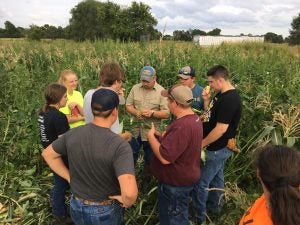The ag labor shortage shows us a huge problem in agriculture — and we need to find a solution
Most farmers and agricultural business owners can tell you that they are having a hard time finding employees. If you are just scrolling through social media, chances are you will see a farm or ag business looking for people to employ. The bigger question is why is there such a shortage of labor, and what does this tell us about the state of agriculture?
Let’s start with the problem. In 2021, 66 percent of respondents to a Purdue University/CME Group survey reported having difficulty finding workers to fill ag jobs. This is a huge increase from 2020, with values more than doubling. Another interesting fact is that 91 percent of ag retailers and 87 percent of farms are finding it harder to fill positions.
While COVID-19 may have an impact on this labor shortage, this problem has been occurring in the ag industry for years.
In 2015, Purdue University estimated that 40 percent of new ag jobs go unfilled each year, and their latest study estimates that from 2020 to 2025, there will be 59,400 job openings in agriculture annually.
I believe that one of the main reasons for our ag labor shortage is a lack of agricultural education and how far removed some people are from agriculture. Because many people lack knowledge of ag, they simply don’t know about all of the career opportunities in ag. In other words, people are becoming less ag literate.

I have also seen our need for ag education first hand. I have given hundreds of presentations to high school students. At the start of every presentation, I ask the students what agriculture is. They always tell me: farms, farmers, crops, and cows. Very few students mention food production, sustainability, business, economics, and the many other things that agriculture is.
The best way to solve the ag labor shortage problem is through education. It is important that everyone, and especially our young people, learn where their food comes from and what job opportunities are available in agriculture.
I have been trying to solve this problem for years. In 2016, I started a project called Beyond the Farm. My goal is to share information about agriculture and its careers with as many people as I can. Over the past five years, I’ve presented in front of thousands of people across the country, created videos to tell the story of agriculture, and formed my social media presence.
I can tell you from experience that ag education works. In 2020, I wrote a free curriculum about agricultural careers. I tested this curriculum by using it on over 1,200 high school students. I spent 15 minutes going over the variety of ag careers, showing the students the most in-demand ag careers, and giving them some resources to dive in deeper to ag careers.
I surveyed these students before and after my presentation and found that after 15 minutes, the student’s interest in pursuing an ag career had risen 23 percent. If this is the increase after 15 minutes, imagine how many more students would be interested in an ag career if they took an ag class in school.
I also found that the concept of youth-teaching-youth works. Through these presentations the students responded well because I was close to their age. They found it easier to ask me questions and pay attention to what I was showing them.
The most obvious way to increase ag education is to get more ag classes in schools, but this can be a challenge due to a lack of available and experienced teachers and a lack of school funding and support for ag classes.
Another way to increase ag literacy is encouraging people to participate in ag activities and organizations. Farm tours and breakfasts on the farm are great examples of this. Visiting county fairs and participating in agri-tourism are other great activities. Agri-tourism is still an emerging industry, but it’s a great way to support farms and share the story of ag. We should also be encouraging students to participate in 4-H and FFA. By engaging in fun activities like these, people don’t even realize that they’re learning.
One of my favorite ways to educate others about ag is through social media. Social media is great because it can reach almost everybody, and it’s a great way to share how fun and exciting agriculture is. You can get involved by sharing your ag story on social media or by following and supporting some of the amazing ag-vocate accounts out there.
More ag education is needed, everyone can help by promoting agriculture. Talk about ag with your friends and family, and do your best to promote it in schools. Share your ag story and do your best to support young people who are getting involved in ag. Together we can increase ag education, prepare the next generation for careers in agriculture, and create more agriculturally literate adults.


